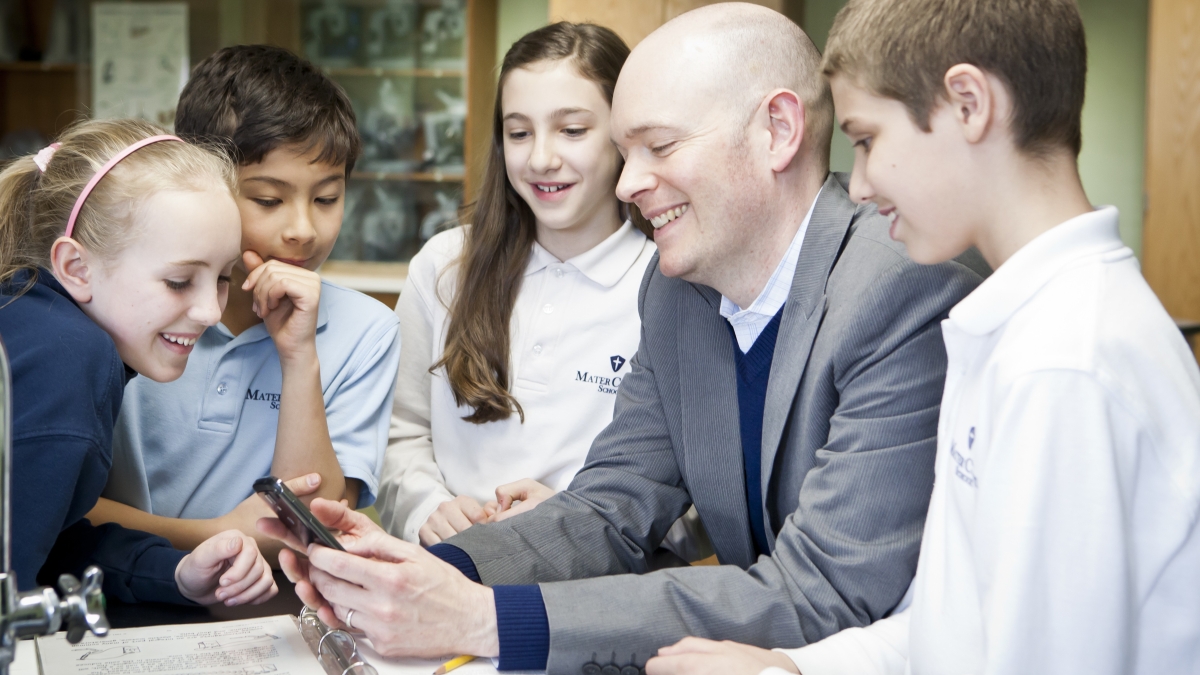Futurist Brian David Johnson leaves Intel, joins ASU

Brian David Johnson talks with students about futurism and robotics at Mater Christi School in Burlington, Vermont. Photo by Sarah Lavoie/Courtesy of Mater Christi School.
Renowned futurist, technologist and author Brian David Johnson, who left his position at the Intel Corporation in January, will be joining Arizona State University as Futurist in Residence for spring 2016 at the Center for Science and the Imagination (CSI) and as a Professor of Practice in the School for the Future of Innovation in Society. Johnson has worked at Intel and collaborated with a variety of private-sector partners since 2002, and was named the corporation’s first futurist in 2009.
“I’m so excited about the future and what we’ll be able to accomplish,” Johnson said. “ASU is one of the world’s most innovative and forward-looking institutions. It’s the perfect place to collaborate with a broad, diverse set of people and to explore the future in exciting, intellectually rigorous and surprising ways.”
Johnson will use his appointment at ASU to lead two exciting projects of great public interest designed to ignite new conversations about the future we’re building together:
• The Future of the American Dream Project takes the methods and perspectives Johnson has honed as a technological futurist and applies them to an issue that everyone has a strong opinion about. He asks: What’s the future of the American Dream? How are our definitions of the American Dream changing? How do diverse groups of people imagine the American Dream, and how can we reimagine it as a more inclusive concept? How will changes in economics, education and technology lead to new American Dreams? Johnson will tap into ASU’s expansive global network, deep community connections, talented student population and interdisciplinary research enterprise to explore these and other questions through interviews, field trips, town halls, videos, podcasts and more.
• 21st Century Robot aspires to get a programmable, humanoid, 3-D-printed, custom-built robot into the hands of every kid. Based on Johnson’s 2014 book "21st Century Robot," the project is built on open-source hardware and software and features an easy-to-use app system, so kids and less experienced users can create robots who sing, tell jokes and run away from loud noises — in short, robots with personalities, and robots who reflect the personalities of their creators.
“We’re tremendously excited to have Brian in residence at CSI this spring. In joining our community, he will help create meaningful connections with collaborators across the technology sector and add new dimensions to the center’s mission of creating ambitious, compelling visions of the future,” said Ed Finn, director of CSI. “We are also thrilled to provide a platform for Brian to take his work as a futurist in new directions: exploring the possibilities of crowdsourced technological and artistic imagination with the 21st Century Robot Project, and delving into economic, political and cultural futures with The Future of the American Dream.”
Johnson will design and lead a graduate studio course for the School for the Future of Innovation in Society on the Future of the American Dream, together with Michael Bennett, an associate research professor at the school and CSI, and Lauren Withycombe Keeler, a postdoctoral scholar at ASU’s Center for Nanotechnology and Society. He will also participate in a variety of ASU research initiatives, public events and workshops, and help develop actionable visions for the future of the school, CSI and other innovative ASU programs.
“Brian’s presence on campus, and particularly his role in delivering a practice-oriented graduate course, will be a great opportunity for students to both learn various techniques used in the private sector to grapple with futurecasting and to hone their skills on real-world problems. Having been a pupil of Brian’s in his workshop on science fiction prototyping at the first Emerge event in 2012, I can’t imagine a more gifted leader for the students in this class,” said Dave Guston, founding director of the School for the Future of Innovation in Society.
Johnson has been an active supporter of ASU’s science and society endeavors since 2012, where he was one of the featured speakers at the launch of the Center for Science and the Imagination. He is the leader of The Tomorrow Project, which has collaborated with the center and the Society for Science and the Public to publish five books of science fiction stories, essays, interviews and artwork with contributions from K-12 and college students worldwide along with top authors, scientists, technologists and journalists. He was also a contributor to the center’s Sprint Beyond the Book project, a series of experiments in rapid digital publishing that unfolded at the Frankfurt Book Fair, Stanford University and ASU in 2013 and 2014. In 2012, Johnson led a workshop at ASU’s Emerge festival on prototyping the future with science fiction, and presented an exhibit of design fiction costumes, sets and story fragments exploring a range of possible futures, titled “Powered by Fiction: Artists, Makers, Tinkerers, and the Backstories That Inspire Them to Create.” Last fall, he gave a public lecture at the School for the Future of Innovation in Society on robotics, emotion, and relationships between humans and technology.
Johnson is a Futurist and Fellow at Frost and Sullivan, a visionary innovation company that’s focused on growth. He also works with governments, militaries, trade organizations and start-ups to help them envision their future. He has more than 30 patents and is the author of a number of books of fiction and nonfiction, including "Science Fiction Prototyping"; "Screen Future: The Future of Entertainment, Computing and the Devices We Love"; "Humanity and the Machine: What Comes After Greed?"; and "Vintage Tomorrows: A Historian and a Futurist Journey Through Steampunk Into the Future of Technology." His writing has appeared in publications ranging from the Wall Street Journal and Slate to IEEE Computer and Successful Farming, and he appears regularly on Bloomberg TV, PBS, Fox News and the Discovery Channel. He has directed two feature films and is an illustrator and commissioned painter.
More Science and technology

ASU professor shares the science behind making successful New Year's resolutions
Making New Year’s resolutions is easy. Executing them? Not so much.But what if we're going about it all wrong? Does real change…

ASU student-run podcast shares personal stories from the lives of scientists
Everyone has a story.Some are inspirational. Others are cautionary. But most are narratives of a person’s path, sometimes a…

The meteorite effect
By Bret HovellEditor's note: This story is featured in the winter 2025 issue of ASU Thrive.On Nov. 9, 1923, Harvey Nininger saw…